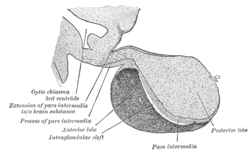Posterior pituitary
| Posterior pituitary | |
|---|---|
| File:Pituitary gland.PNG Pituitary gland. Posterior pituitary is in blue. Pars nervosa and infundibular stalk are not labeled, but pars nervosa is at bottom and infundibular stalk is at top.) | |
 Median sagittal through the hypophysis of an adult monkey. (Posterior lobe labeled at bottom right.) | |
| Details | |
| Precursor | Neural tube (downward-growth of the diencephalon)[1] |
| Artery | inferior hypophyseal artery |
| Vein | hypophyseal vein |
| Identifiers | |
| MeSH | D010904 |
| NeuroNames | 401 |
| NeuroLex ID | birnlex_1586 |
| TA98 | A11.1.00.006 |
| TA2 | 3859 |
| FMA | 74636 |
| Anatomical terminology | |
The posterior pituitary (or neurohypophysis) comprises the posterior lobe of the pituitary gland and is part of the endocrine system.
Anatomy
The Posterior Pituitary Gland consists mainly of neuronal projections (axons) extending from the supraoptic and paraventricular nuclei of the hypothalamus that secrete peptide hormones into the capillaries of the hypophyseal circulation.
The neurohypophysis also contains a specialised type of astrocytic glial cell - "pituicytes".
Despite its name, the posterior pituitary gland is not a gland, per se; rather, it is largely a collection of axonal projections from the hypothalamus that terminate behind the anterior pituitary gland.
Classification of the posterior pituitary varies, but most sources include the three regions below:
| Region | Description |
| pars nervosa, or neural lobe, or posterior lobe | This region consistutes the majority of the posterior pituitary, and is sometimes (incorrectly) considered synonymous with it. Notable features include Herring bodies and pituicytes. [2] |
| infundibular stalk | Also known as the "infundibulum" or "pituitary stalk". The term "hypothalamic-hypophyseal tract" is a near-synonym, describing the connection rather than the structure. |
| median eminence | This is only occasionally included as part of the posterior pituitary. Other sources specifically exclude it from the pituitary.[3] |
A few sources include the pars intermedia as part of the posterior lobe, but this is a minority view. It is based upon the gross anatomical separation of the posterior and anterior pituitary along the cystic remnants of Rathke's pouch, causing the pars intermedia to remain attached to the neurohypophysis.
Major hormones secreted
Hormones known classically as posterior pituitary hormones are synthesized by the hypothalamus. They are then stored and secreted by the posterior pituitary into the bloodstream.
| Hormone | Other names | Symbol(s) | Target | Effect | Source |
|---|---|---|---|---|---|
| Oxytocin | - | - | Uterus, mammary glands | Uterine contractions; lactation | supraoptic and paraventricular nuclei |
| Vasopressin Antidiuretic Hormone | Arginine vasopressin, argipressin, antidiuretic hormone | AVP, ADH | Kidneys or Arterioles | Stimulates water retention; raises blood pressure by contracting arterioles, induces male aggression | supraoptic and paraventricular nuclei |
Role in disease
Insufficient secretion of vasopressin is central to diabetes insipidus, in which the body loses the capacity to concentrate urine. Affected individuals excrete as much as 20 L of dilute urine per day.
Oversecretion of vasopressin causes the syndrome of inappropriate antidiuretic hormone.
References
- ^ Embryology at unc.edu
- ^ Histology image: 14004loa – Histology Learning System at Boston University
- ^ Median+eminence at the U.S. National Library of Medicine Medical Subject Headings (MeSH)
Additional images
-
The posterior pituitary comprises the posterior lobe of the pituitary gland.
-
Hypothalamic nuclei



